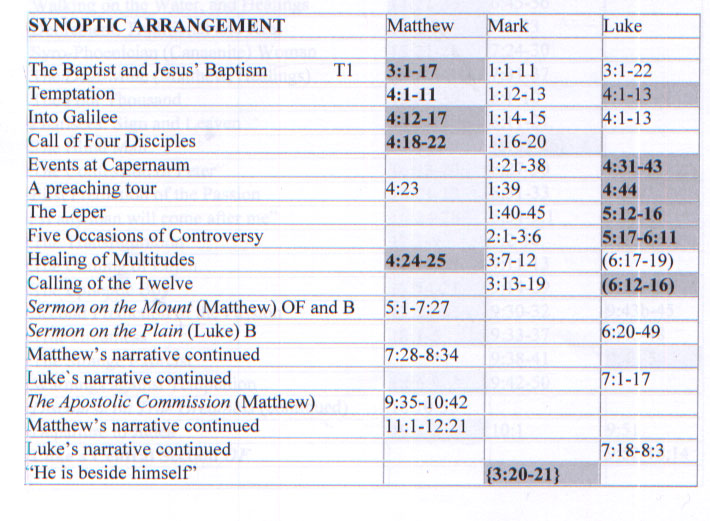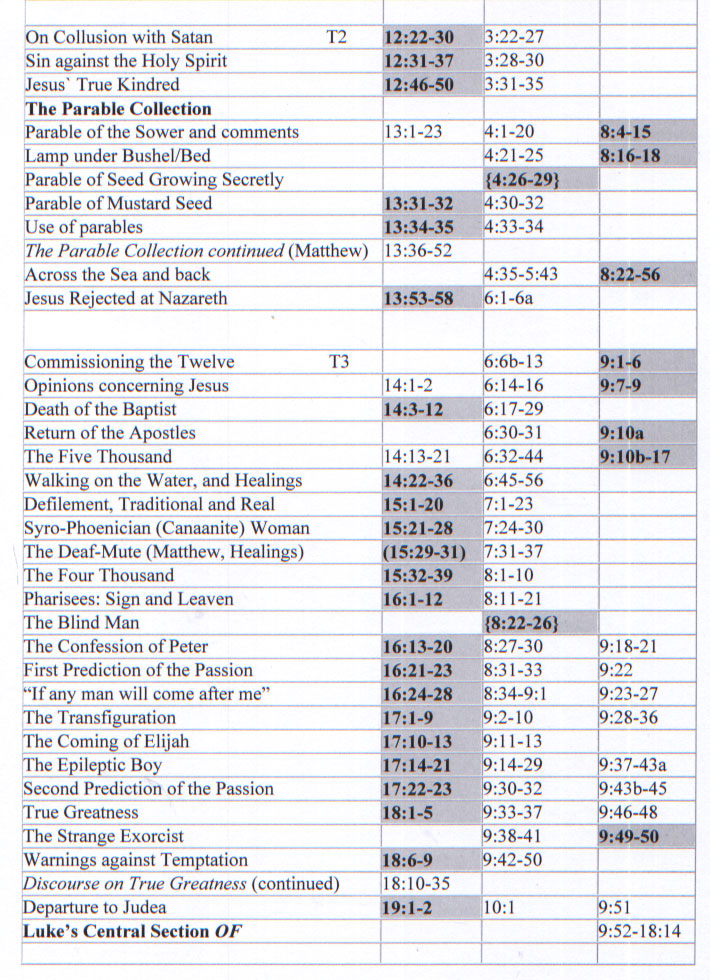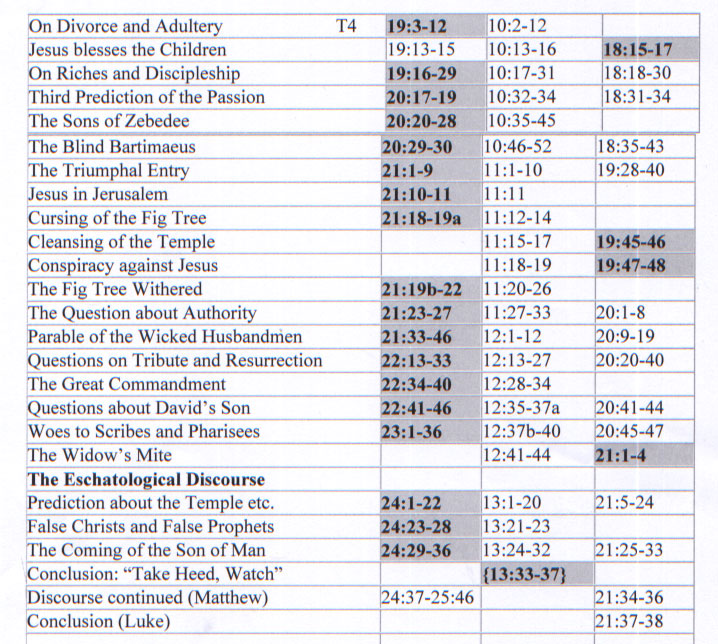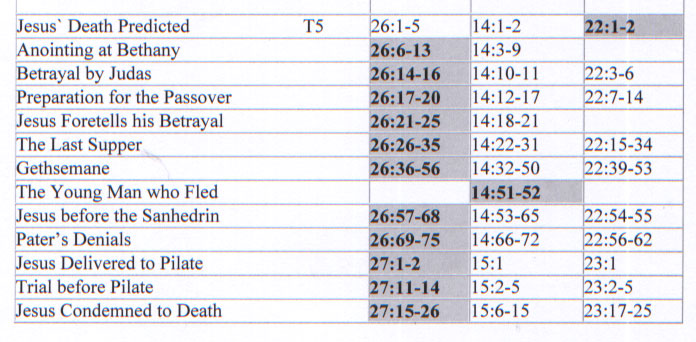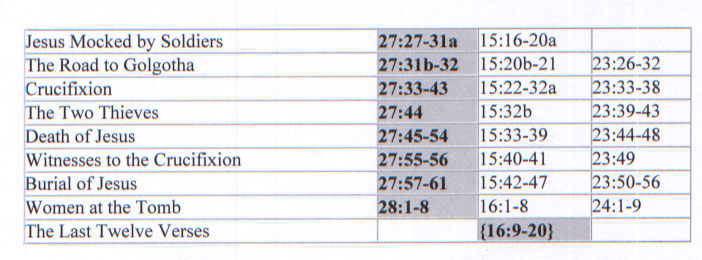|
CHAPTER 2 The Clementine tradition, revived in 1764 by Henry Owen ((HO)), holds that Mark’s Gospel was formed by the conflation (two streams mixing to form one stream) of Matthew and Luke. When placed side by side (a synoptic arrangement) we can see where borrowing has taken place. A Synoptic arrangement may vary slightly depending on how the gospel verses and pericopes are divided. (A pericope is a small section or sub-section of a verse). When illustrating, below, this zigzag effect, the works of several authors were consulted, including H. Riley ((RO 4-18)), Orchard ((RO 263-272)) and Meijboom ((JJK 151-155)). Where Matthew and Luke are identical, we are not able to decide which gospel Mark/ Peter was following at that moment. But a small variation can provide a clue. For example, at the Transfiguration Mark follows Matthew’s ‘six days’ rather than Luke’s ‘about eight days’. From the shaded areas we are able to see how Mark’s Gospel borrowed alternatively from the existing two Gospels. OF indicates: ‘The Our Father’ and B: ‘The Beatitudes’. Mark’s own verses are indicated by { }. T is where Orchard suggests Peter started each talk. The chart illustrates the alternating borrowing of complete verses, but is not detailed enough to indicate the borrowing of individual words or phrases. For example: Although Mark 6: 7-16 as a whole is drawn from Luke, the words in 6:14 are from Matthew. Although Mark 8: 27-10: 40 is mainly taken from Matthew, the influence of Luke may be seen in 8:38, 9:32-33. ((JJK 153-5)).
The three gospels of Matthew, Luke and Mark are often referred to as: ‘the Synoptic Gospels’. According to the Markan priority theory, when Matthew ceases to follow the order of Mark, Luke continues in it until Luke ceases when Matthew takes over. This continues throughout the Gospels. This could only have been accomplished if Matthew and Luke co-ordinated their work very closely. But, according to the Markan theory, these Gospels were created in separate communities that were out of touch with one another. This is an insoluble difficulty for the Markans. This difficulty also applies to other phrases. Matthew and Luke use exactly the same five Greek words to form a phrase concerning Peter’s denial. Mark uses three different words conveying the same meaning (Mark 14: 72). If Markan priority is correct, Matthew and Luke chose the same phrase without having been in contact with each another ((DBP 303)). DUPLICATIONS The duplications of Mark are a feature of his style. They are often referred to as his ‘redundant
clauses’ or ‘duality’. To take an example:- Matthew and Luke would have had to divide up Mark’s dualities between them in a consistent manner to avoid them using the same half. The only way this could have been achieved would be for their gospels to have been brought together in some way. Again the advocates of Markan priority meet the problem that, according to them, Matthew and Luke did not know one another.
A CHALLENGE Realising the strength of the Clementine case, Markans have attempted to answer this problem. In 1983, C.M.Tuckett claimed there were 213 dualities in Mark’s gospel, so chance would explain the 17 cases where Matthew and Luke chose different halves ((CMT 20-21)). At first this appears a plausible argument, and many feel overawed by statistics. A few comments are therefore required. 1). Let us presume for the moment, that Markan priority is correct. Of the 213 dualities Matthew and Luke did not use either half in 157 of them. It is correct that 39 do not use the same half. But these instances are where dualities are vague or do not have ‘equal value’ (i.e. one word is more suitable than the other, so was highly likely to be chosen by both). The debate must be judged on the 17 cases where there is a clear duality of equal value and meaning (e.g. ‘evening’ and ‘sunset’). Markans need to explain why, whenever there was such a choice, Matthew and Luke always chose differently. 2. An interesting observation may also be made regarding the 213 dualities examined by Tuckett. Matthew has one or both halves 152 times, of which 124 are when Matthew and Mark are in the same sequence. Luke has one or both 116 times, of which 114 are when one or both are in the same sequence. This is further support for the view that Mark was conflating the other two. 3. As Riley has pointed out, the normally accepted number of dualisms as listed by Neirynck, a Markan, is 217. Tuckett omits many of these while adding others of his own. So the statistical basis for his calculations is itself open to questioning ((RO107-8)). 4. A more detailed response to Tucket was made in 1987 Of the ten healing stories in Mark, eight appear in Matthew and Luke. Both had chosen exactly the same eight ((WRF 166-7)). Mark lists six Commandments (Mark 10: 19). Matthew and Luke list five and these are exactly the same five ((WRF 160)). If Mark was reading from the other two there is no problem in accepting that he copied what was
in front of him and added something of his own.
.
|
